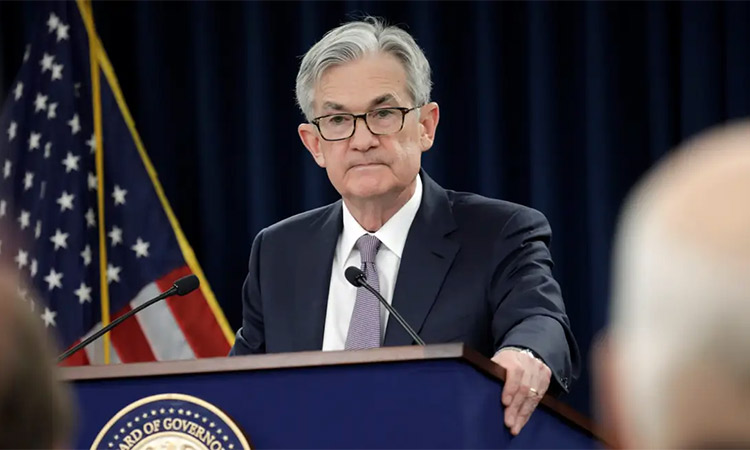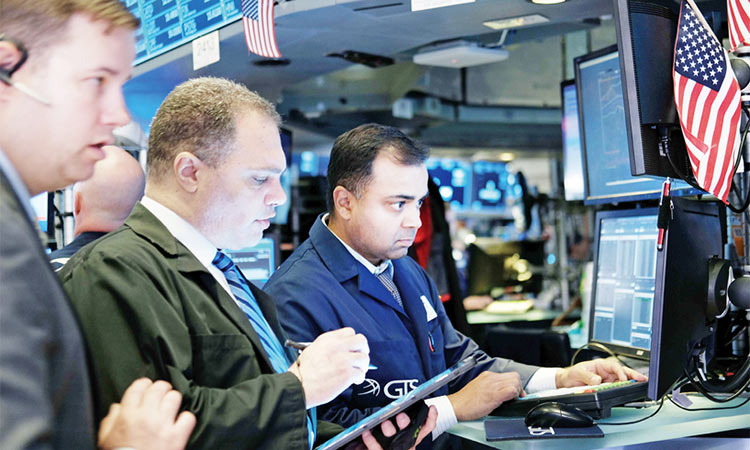Global stock markets edge down from latest all-time record highs

European Council President Charles Michel (right) and European Commission President Ursula von der Leyen address a media conference at the conclusion of an EU Summit in Brussels, Belgium, on Friday. European Union leaders on Friday discussed plans to boost investment and the economy. Associated Press
A surprise rate cut from Switzerland’s central bank on Thursday helped push markets to new highs, as traders realised that major central banks around the world would not necessarily wait for US Federal Reserve rate cuts before delivering their own.
Wall Street rallied overnight, with all three major indexes extending their streak of record highs. But sentiment turned more cautious on Friday.
At 1239 GMT, the MSCI World Equity Index was down 0.1% on the day, but up 1.9% on the week as a whole, on track for its biggest weekly gain so far this year.
In a busy week for markets, traders drew confidence not only from Switzerland’s rate cut on Thursday, but also from the Bank of England being more dovish than expected. The BoE said the economy is “moving in the right direction” for it to start cutting rates.
Europe’s STOXX 600 was down 0.1%, after touching a new all-time high, while London’s FTSE 100 was up 0.5%, helped by expectations that the Bank Of England would cut rates sooner than previously thought. BoE Governor Andrew Bailey saying in a Financial Times interview that the expectation of more interest rate cuts this year on a whole was not “unreasonable”.
MSCI’s Europe index was down 0.4% and France’s CAC 40 was also down 0.4%.
Wall Street futures were up, as traders waited for commentary from Fed Chair Jerome Powell later in the day.
The US Federal Reserve said at its meeting on Wednesday that recent high inflation readings had not changed the underlying “story” of slowly easing price pressures.
“I think there might be some profit-taking at the end of the week, just because of the amount of data that we’ve seen and the fact that we have seen more positive surprises,” said Baylee Wakefield, multi-asset fund manager at Aviva.
Trading may also reduce in the lead-up to the Easter weekend, Wakefield added.
The U.S. dollar index was up 0.4% at 104.23, on track for its best week since the first week of the year.
“The dollar’s basically going to have its best week since January and that is because markets are now accepting that other major central banks will reduce their policy rate faster than the Fed, especially because we’ve had further evidence from the strong economic data we’ve had out of the U.S. this week,” Aviva’s Wakefield said.
U.S. jobless claims unexpectedly fell, sales of previously owned homes increased by the most in a year in February and U.S. business activity held steady in March, data this week showed. A gauge of future economic activity in the U.S. turned positive in February for the time in two years.
The euro was down 0.3% at $1.0828. The probability of a European Central Bank rate cut before summer is increasing, Bundesbank President Joachim Nagel said.
The British pound was down 0.3% at $1.26175, having earlier hit a one-month low.
Euro zone government bond yields were set for a weekly decline. The benchmark German 10-year yield was down by 6 basis points at 2.334%.
China’s yuan dropped sharply during Asian trading, hitting a four-month low, in a move analysts attributed to rising expectations that there will be more monetary easing to prop up the country’s economy.
Oil prices were steady, with global benchmark Brent hovering above $85 per barrel. The possibility of a ceasefire in Gaza had pushed prices lower earlier in the session. The stronger dollar and lower U.S. gasoline demand also weighed on prices.
Gold was down 0.3% at $2,174.48 per ounce, having hit a record bid high of $2,222.39 on Thursday.
Investment flows into gold in the week to Wednesday reached their highest in almost a year, Bank of America Global Research said.
Oil prices were stable on Friday, with global benchmark Brent hovering above $86 per barrel, as the possibility of a ceasefire in Gaza gained traction.
Brent crude futures were up 26 cents at $86.04 a barrel by 1306 GMT. U.S. crude futures were up 28 cents at $81.35 per barrel.
U.S. Secretary of State Antony Blinken said on Thursday he believed talks in Qatar could reach a Gaza ceasefire agreement between Israel and Hamas.
Blinken met Arab foreign ministers and Egypt’s President Abdel Fattah El-Sisi in Cairo as negotiators in Qatar centred on a truce of about six weeks.
“A ceasefire would help calm fears that the situation in Gaza might spread more broadly across the region,” IG analyst Tony Sycamore said.
“Additionally, it may encourage the Houthis to stand down and allow oil tankers to pass through the Red Sea, which would also be a positive development in terms of helping to balance out the supply and demand dynamics.”
Meanwhile, Russia launched the largest missile and drone attack on Ukrainian energy infrastructure of the war to date on Friday, hitting the country’s largest dam and causing blackouts in several regions, Kyiv said.
Ukraine has in recent weeks masterminded a series of attacks on Russian energy infrastructure. The United States has reportedly urged Kyiv to halt strikes on facilities, warning that they risk provoking retaliation and driving up oil prices.
In the United States, the world’s top oil consumer, gasoline product supplied, a proxy for demand, slipped below 9 million barrels for the first time in three weeks, indicating a possible slowdown in crude demand.
However, consultancy FGE said preliminary weekly data for the first half of March that showed on-land crude and main product stocks at major oil hubs globally falling by almost 12 million barrels, compared with the 2015 to 2019 average draw of 6 million barrels, could be bullish for oil.
Meanwhile, the U.S. dollar strengthened after the Swiss National Bank’s surprise interest rate cut on Thursday bolstered global risk sentiment.
A stronger dollar makes oil more expensive for investors holding other currencies, dampening demand.
Agencies MORE: P 17







